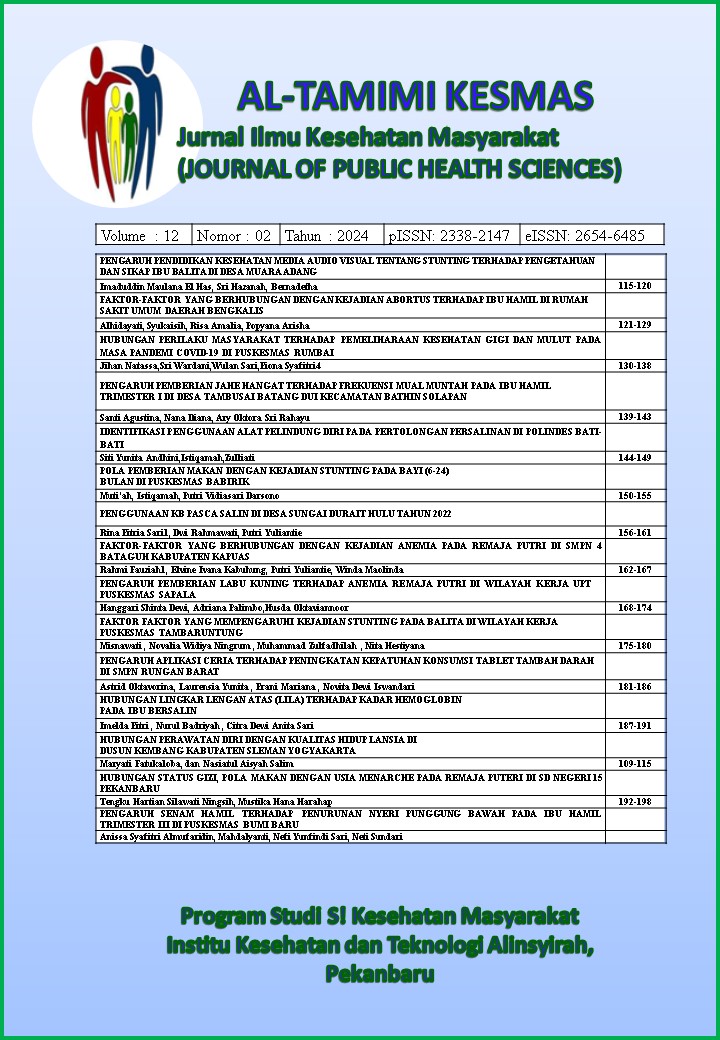PENGGUNAAN KB PASCA SALINDI DESA SUNGAI DURAIT HULU TAHUN 2022
DOI:
https://doi.org/10.35328/kesmas.v12i2.2599Keywords:
Jenis KB, KB Pasca Salin, Paritas, Umur.Abstract
BKKBN has a target in 2022 of 70% of prospective mothers participating in the postpartum family planning program. In Indonesia, less than 30% are interested in using postpartum birth control. The use of postpartum birth control is the government's target in reducing population growth and one of the efforts to reduce birth and death rates. The village with the lowest post-natal family planning achievement is Sungai Durait Hulu Village, out of 23 villages in Babirik sub-district. The aim of this research is to determine the use of post-saline family planning in Sungai Durait Hulu Village in 2022. Quantitative descriptive research using secondary data analysis (ADS). The sample included in this research was postpartum mothers in Sungai Durait Hulu village from January to December 2022. The total population was 12 postpartum mothers, the sampling technique used was total sampling. From univariate analysis, it was found that 83.3% of postpartum mothers were 20-35 years old, parity was 75% multiparous. The type of contraception used by 66.7% was injection, and 58.3% of postpartum mothers used postpartum birth control. Characteristics were obtained from postpartum mothers aged 20-35 years with multiparous parity. The most popular type of postpartum birth control is the injectable type of birth control.
References
Amra. (2018). Determinan penggunaan alat kontrasepsi pada ibu pasca nifas di wilayah kerja puskesmas tamalanrea kota makassar.
Arfiyanty, Y., & Palinggi, E. (2022). Hubungan Kunjungan dan Konseling Masa Nifas Dengan Penggunaan Kb Pasca Salin Di Puskesmas Ulusalu Tahun 2021. 1(1), 12–20.
BKKBN. (2021). Hasil Pelayanan Peserta Kb Baru Pasca Persalinan Dan Keguguran Menurut Metode Kontrasepsi Tahun 2021. http://aplikasi.bkkbn.go.id/sr/Klinik/Laporan2013/Bulanan/Faskes2013Tabel5a.aspx
BKKBN. (2022). BKKBN 2020-2024.
BPS. (2022). Jumlah Penduduk Pertengahan Tahun (Ribu Jiwa), 2020-2022. https://www.bps.go.id/indicator/12/1975/1/jumlah-penduduk-pertengahan-tahun.html
Dinas Kesehatan Provinsi Kalimantan Selatan. (2021). Profil Kesehatan Provinsi Kalimantan Selatan. Timesindonesia, 2020(0751), 2021. https://www.timesindonesia.co.id/read/news/336019/setahun-pandemi-pernikahan-usia-dini-di-ngawi-terus-mengalami-kenaikan
Hanafi, F. (2019). Pemilihan Metode Kontrasepsi Oleh Ibu Akseptor Kb. Jurnal Kedokteran, 4(2). https://doi.org/10.36679/kedokteran.v4i2.105
Hardani, H., Medica, P., Husada, F., Andriani, H., Sukmana, D. J., Mada, U. G., & Fardani, R. (2020). Buku Metode Penelitian Kualitatif & Kuantitatif (Issue April).
Kementrian Kesehatan Republik Indonesia. (2019). Laporan Riskesdas 2018 Nasional.pdf (p. 674).
Laporan Tahunan Bidan Desa Sungai Durait Hulu. (2022).
Laput, D. O. (2020). Pengaruh Paritas Terhadap Penggunaan Kontrasepsi Implant Di Wilayah Kerja Puskesmas Wae Mbeleng ,. 10, 6–10.
Panggabean, S., Siti Erika, & Purnomo, A. (2020). Pendidikan Kesehatan Pentingnya Kunjungan Nifas Kf- 3 Di Kampung Dapur 6 Kelurahan Sembulang Kecamatan Galang Kota Batam Tahun 2020. ENLIGHTENMENT : A Journal Of Community Service, 1(1), 6–11. https://doi.org/10.52999/sabb.v1i1.77
Pardosi, M., Nababan, D., Brahmana, N. E., & Sitorus, M. E. (2021). Faktor - Faktor yang Berhubungan dengan Minat Ibu Bersalin dalam Pemilihan Alat Kontrasepsi KB Pascasalin dengan Metode Kontrasepsi Jangka Panjang di Kecamatan Rantau Utara Tahun 2021. Journal of Healtcare Technology and Medicine, 7(2), 1470–1484.
Perka BKKBN. (2017). Peraturan Kepala Badan Kependudukan dan Keluarga Berencana Nasional Nomor 24 Tahun 2017 Tentang Pelayanan Keluarga Berencana Pasca Persalinan dan Pasca Keguguran. Pelayanan Keluarga Berencana Pasca Persalinan Dan Keguguran, 1(1), 64.
Prawirohardjo, S. (2016). Ilmu kebidanan Sarwono Prawirohardjo (S. Prof. dr. Abdul Bari Saifuddin, MPH, SpOG(K) ; dr. Trijatmo Rachimhadhi, SpOG(K), Prof. Dr. dr. Gulardi H. Wiknjosastro (Ed.)). Jakarta : PT. Bina Pustaka Sarwono Prawirohardjo, 2016.
Riastawaty, D. (2021). Faktor-Faktor Yang Berhubungan Dengan Penggunaan KB Pasca Salin Di Desa Bulian Baru Kabupaten Batang Hari Jambi Tahun 2020. Scientia Journal, 10(1), 130–140. https://ftik.unaja.ac.id/index.php/SCJ/article/view/177%0Ahttps://ftik.unaja.ac.id/index.php/SCJ/article/download/177/149
Rufaindah, E., Juwita, S., III Kebidanan, D., & Widyagama Husada, S. (2019). Peningkatan Keikutsertaan KB IUD Pasca Persalinan (Post Partum) dengan Penggunaan Flashcard Saat Homecare Kehamilan Trimester III Di BPM Soemidjah Kota Malang. In JAPI) Jurnal Akses Pengabdian Indonesia (Vol. 4).
Saifuddin. (2014). Buku Panduan Praktis Pelayanan Kontrasepsi. Bina Pustaka Sarwono Prawirahardjo.
Sugiyono. (2018). Metode Penelitian Kulalitatif Kuantitatif dan Kombinasi (Mixed Methods). Bandung: Alfabeta.
Tuginah. (2020). Faktor-Faktor Yang Mempengaruhi Pemilihan Alat Kontrasepsi Pasca Salin. http://repository.poltekkes-smg.ac.id/index.php?p=show_detail&id=23303&keywords=
Wahyu, Y., Indriyani, I., Ypib, S., Jl, M., Gerakan, K. N., 003, M., & Wetan, M. (2020). Faktor-Faktor yang Berhubungan dengan Penggunaan Kontrasepsi IUD pada Ibu Pasca Salin di RSUD Majalengka Kabupaten Majalengka Tahun 2018. Jurnal Kampus STIKes YPIB Majalengka, 8(1).
Downloads
Published
Issue
Section
License
Copyright (c) 2024 Al-Tamimi Kesmas: Jurnal Ilmu Kesehatan Masyarakat (Journal of Public Health Sciences)

This work is licensed under a Creative Commons Attribution 4.0 International License.














